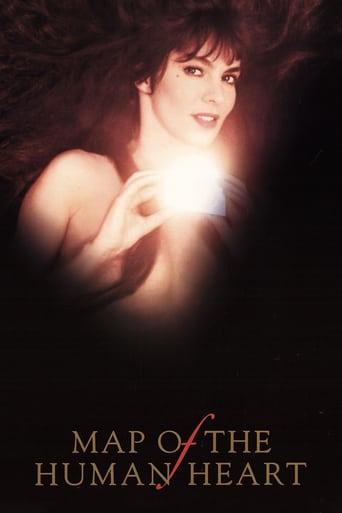Katia Svoka
This movie will rip out your heart. It's the story of an Eskimo man that seems to be cursed from his very birth to lose everything that ever touches his life. It starts out with tragedy and it ends with tragedy. It was a lovely movie but just too sad for me. I used to be in charge of Movie Night at our school's library and we picked this one. By the end of the movie, the other tech and I were the only ones left-everyone else had walked out. Over and over we see this poor guy just get nailed by life. At the end, we finally think things are going to work out for him and BAM! Screwed again. I love movies that evoke deep emotion but this was too much-too depressing for me. Still gave it a good rating thought because it is beautifully done.
AZINDN
Map of the Human Heart is a rare film which is both haunting and beautiful as well as filled with the violence of man against man and nature. It's lead actors, Jason Scott Lee (Avik) and Annie Parlliaud (Albertine) play aboriginals of Canada who are both outcasts by their mixed-blood status in the respective communities, Inuit and Cree, providing insight to the ancient animosity between native groups that shatter the positive stereotype and myth of egalitarian indigenous tribes living in harmony before western contact. In fact, the theme of conflict repeats throughout this fine, little film and provides the backdrop for the love story of Avik and Albertine in WWII England.Discovered as a small boy by a military mapmaker on expedition to his community, Avik, aka "Holy Boy" is drawn to the officer who removes him from his village, a typical action by intrusive, well-intentioned outsiders. Removed to a Catholic run native hospital for treatment, Avik meets the Cree Indian girl, Albertine, a patient with tuberculosis. Historically, the two native groups are ancient enemies, and the children inherited this long-standing animosity without knowing anything of the other until they realize a shared situation and experience. As Avik and Albertine's friendship blossoms, their childhood devotion turns to first love. Avik steals Albertine's x-ray of her damaged lungs and heart which he carries with him into adulthood. The children attempt to run away from the hospital but are thwarted by adult authorities and their separation begins the second half of the film.When the adult Avik returns to his native village to care and provide for his elderly grandmother, he is an unsuccessful as a provider, something seen as a curse to others of the village as well as his grandmother. She realizes Avik must be set free from the ancient ways of native life and commits suicide, a sacrifice of herself for Avik's future. Time and the setting jumps to WWII London where a grown up Albertine is now married to the same British officer who was Avik's liberator. She works with the security branch of the British Army and her unit is responsible to identify sites from the aerial maps for bombing runs turned in by bomber crews. While at work, she reads the name of one of the planes, the "Holy Boy" the childhood name for Avik and reunites with her childhood companion. Their love is rekindled in one of the most memorable settings -- the Royal Albert Hall dome -- where Avik and Albertine escape.The film revels in unlikely settings to situate it's stars adding to the visual and physical splendor of Albertine and Avik's love. From the Royal Albert Hall, to an aerial blimp over the White Horse Vale where they consummate their passion, the cinematography is stunning! Contrasted against this splendor is the reality of the war. The missions to destroy cities and ultimately humans is carnage in acts of violence that is the reality of war. Avik, faced with Albertine's marriage to the man who changed his life, confronts the mapmaker, a jealous controlling man. Albertine's passionate love for Avik is unbearable and he orders Avik's unit back to the "Holy Boy" to take part in one last run that is the controversial bombing of Dresden, Germany. A city acknowledged as a cultural treasure and not factory of Nazi ammunitions manufacture, Dresden was off-limits to bombing runs by Allied troops. However, the hatred for Avik and Albertine's love drives the mapmaker to order the firebombing of Dresden, with the participation of the "Holy Boy." Shot down during the offensive, Avik parachutes into Dresden as the flame offensive engulfs the city. Trying to save a child from the flames, Avik drops the x-ray of Albertine's heart, a symbol of his constant devotion and love, in the conflagration. The conclusion of the film is a heart-wrenching resolution that remains true to the storyline and by the end, the story comes full-circle. The film remains little known but is a captivating romantic adventure which should have received more recognition for both originality and camera-work. It is worthy of attention and delivers with thoughtful commentary on the human heart, loyalty, and hatred.
Jeff Blanco
I had to drive 38 miles to see it..But it was fantastic. I'm usually a "guy Movie" person, but this film moved me so profoundly. The ending was extremely sad. A beautiful movie anyone would enjoy.



